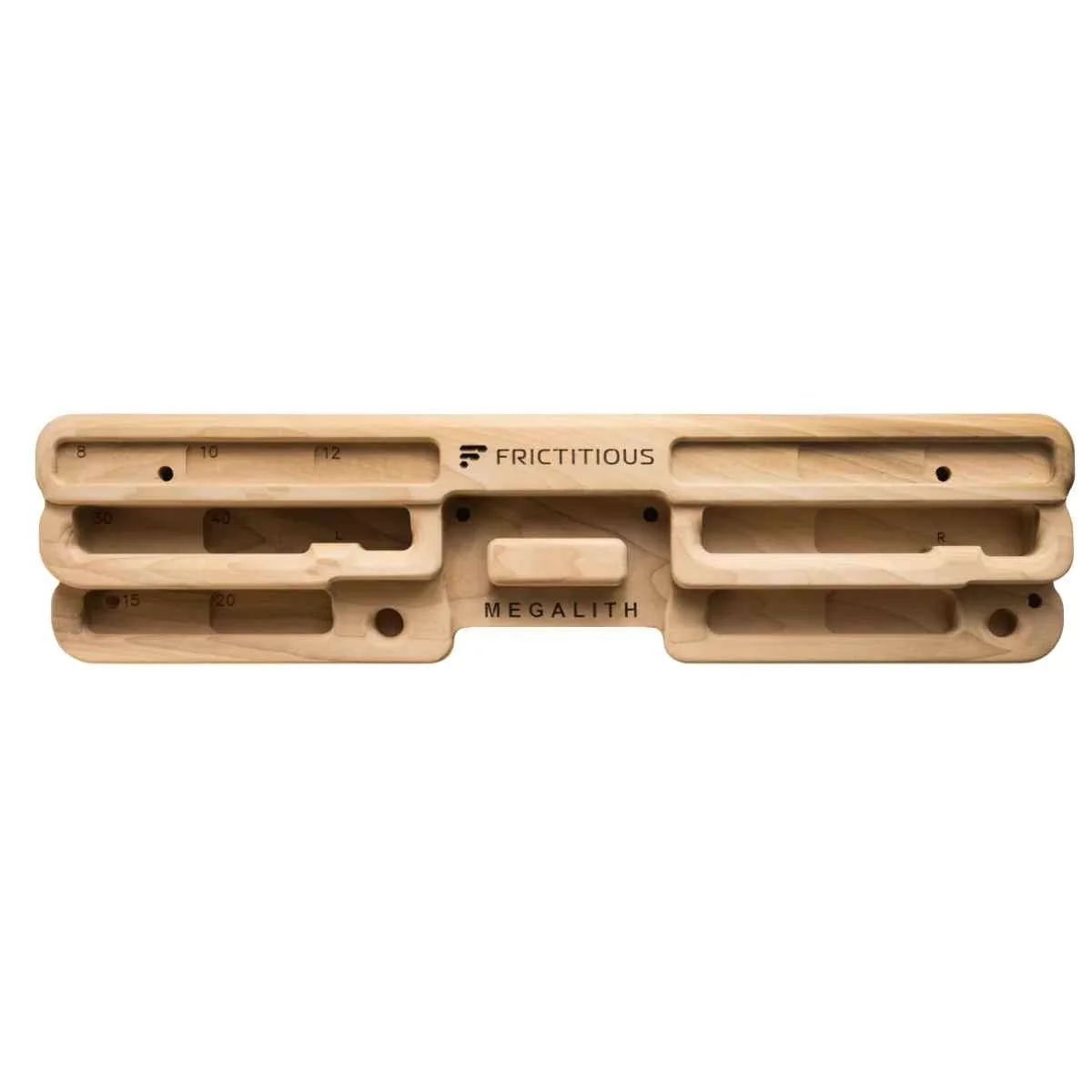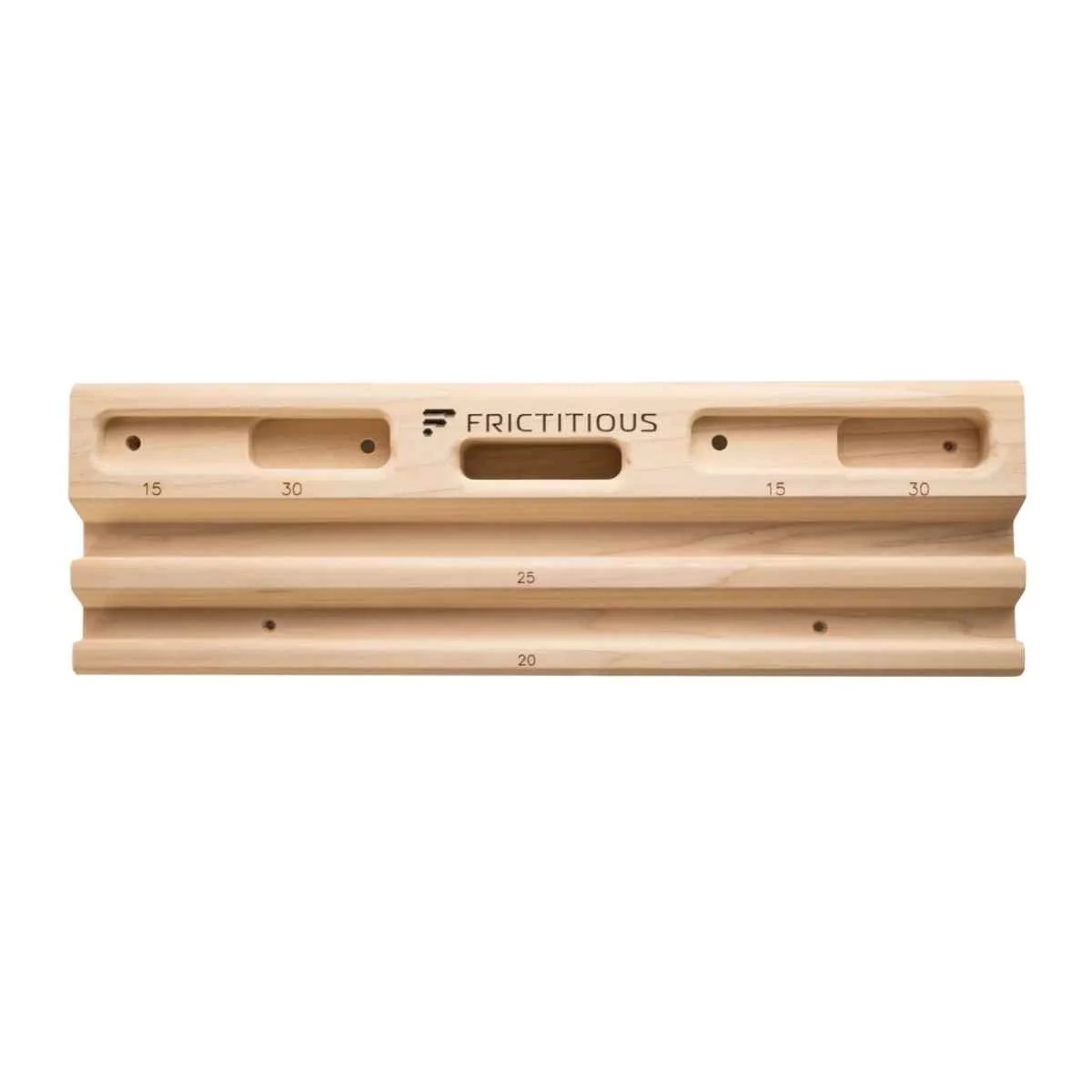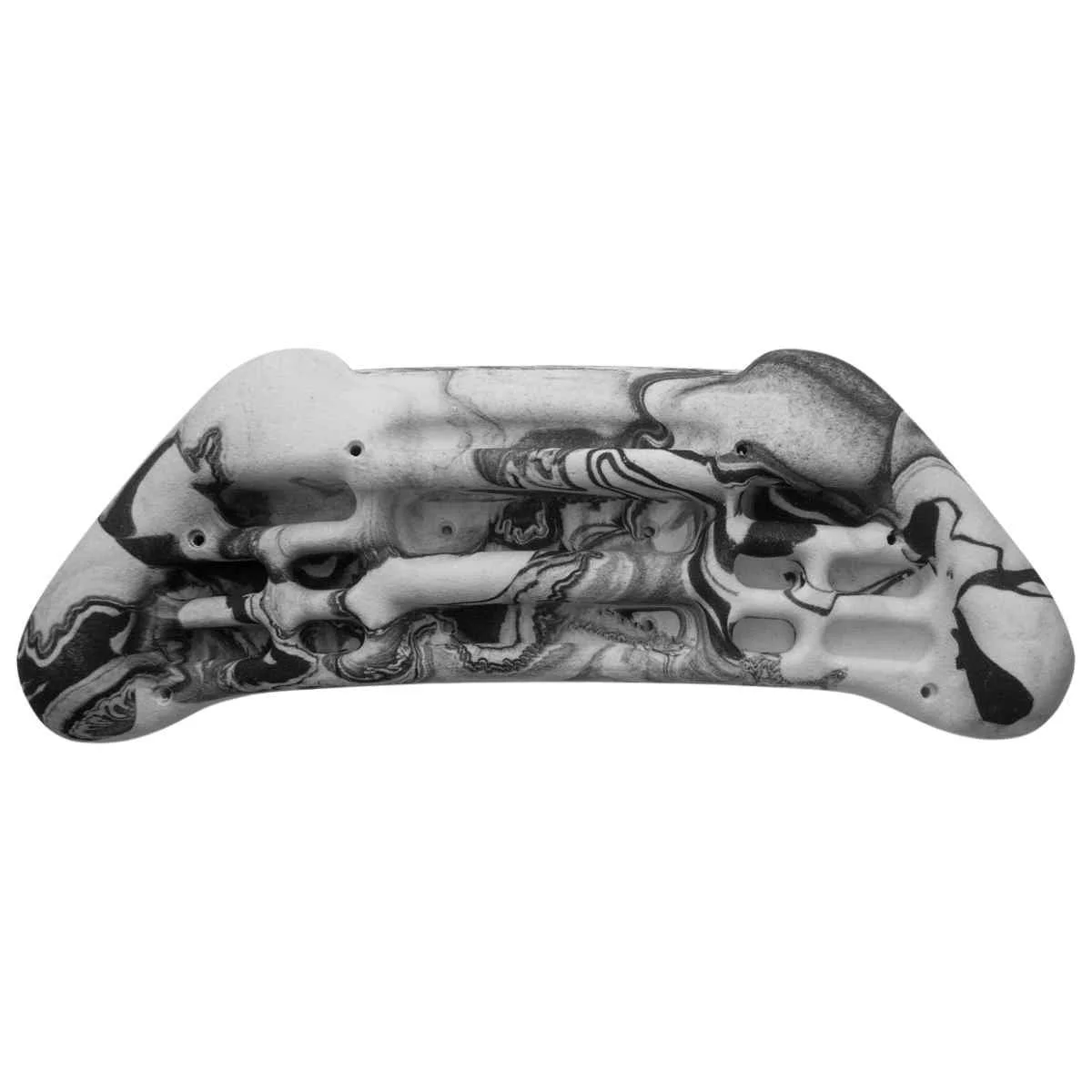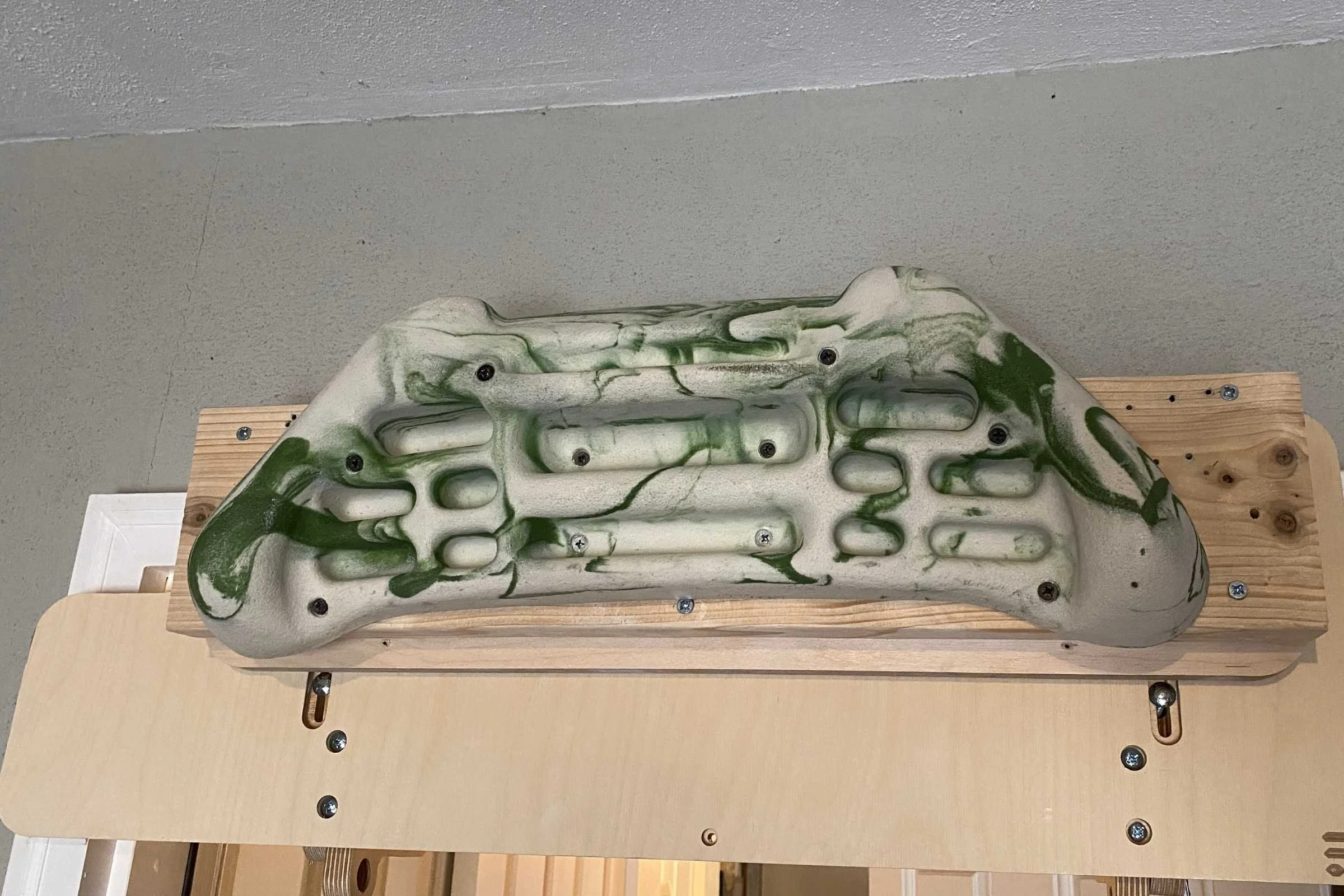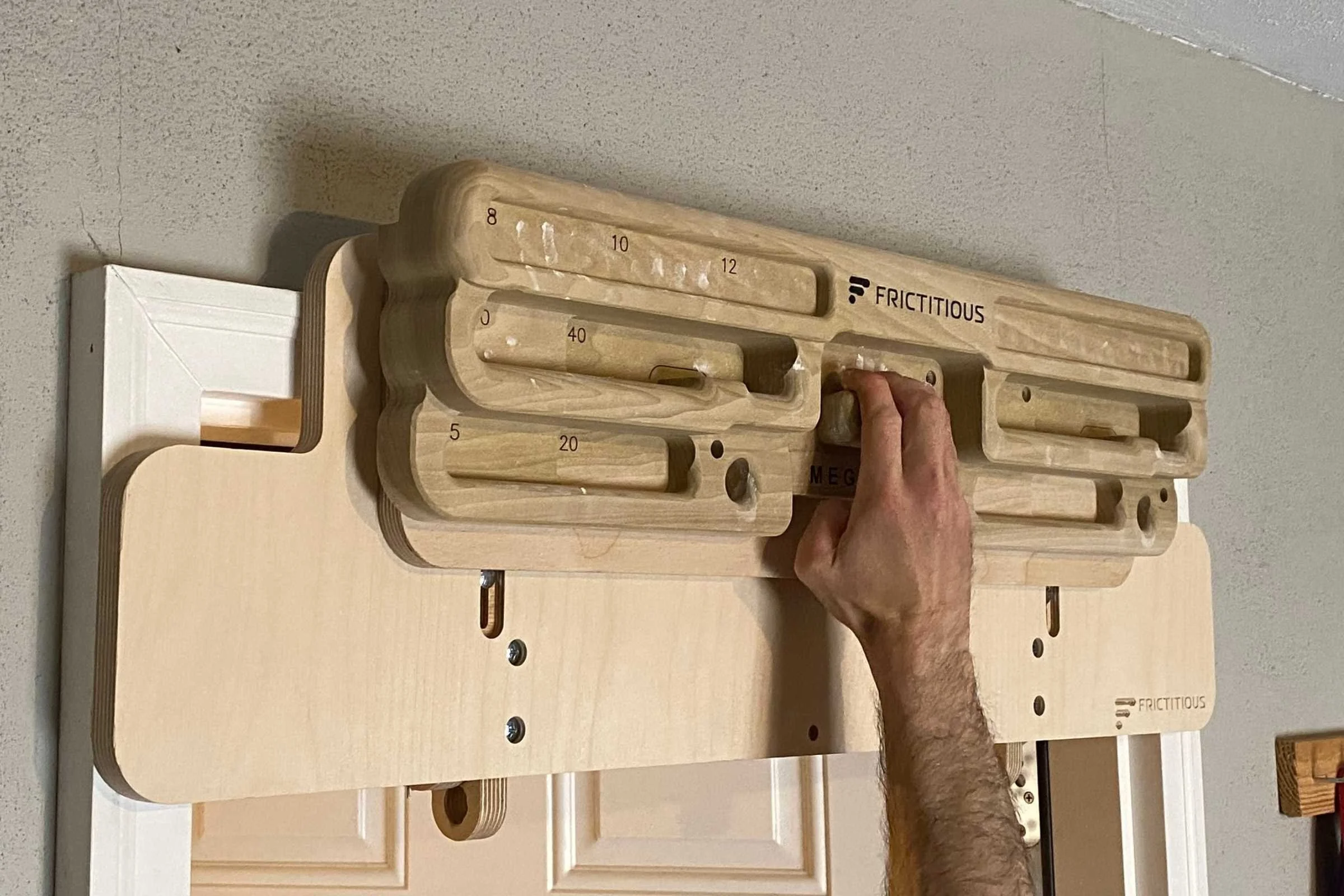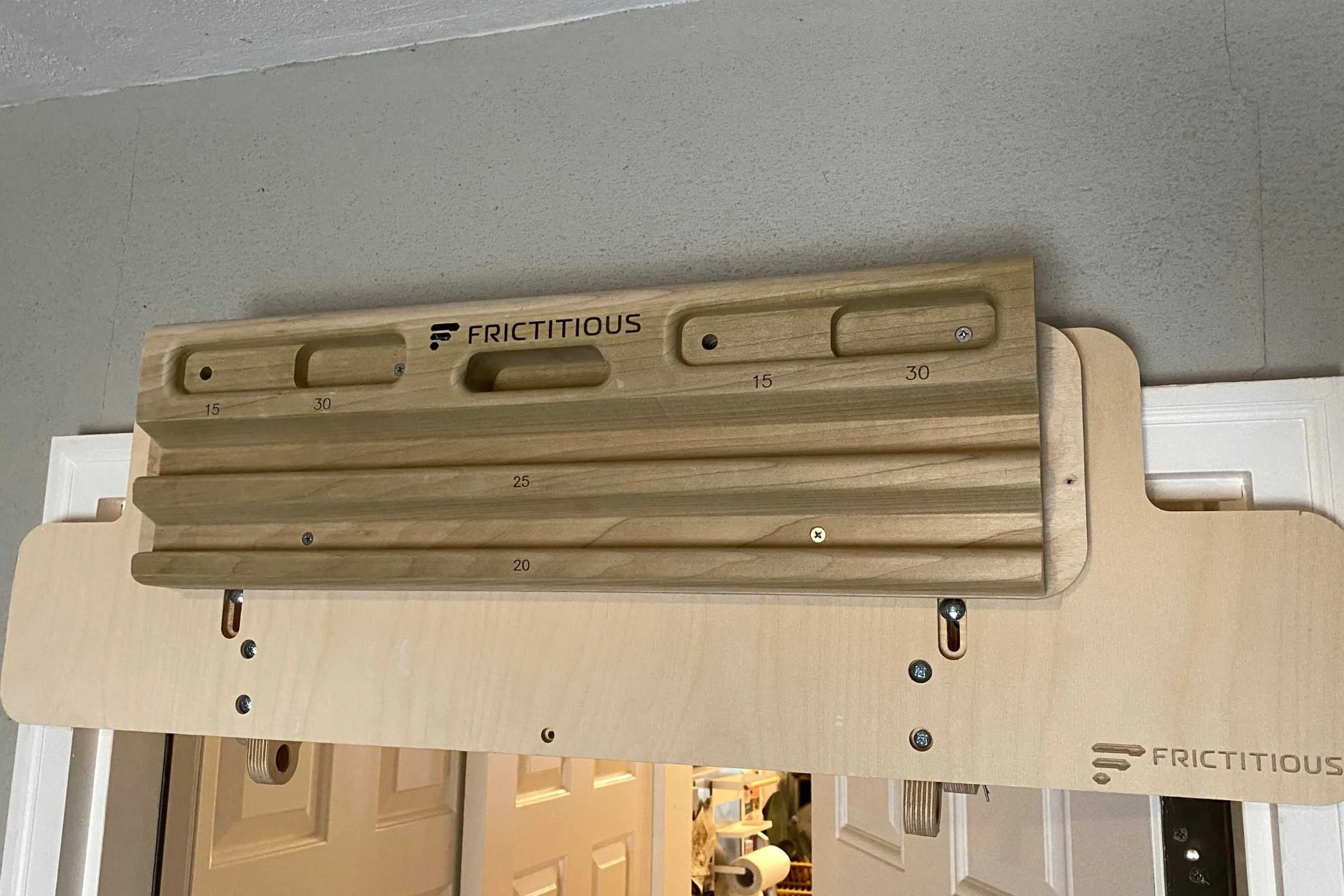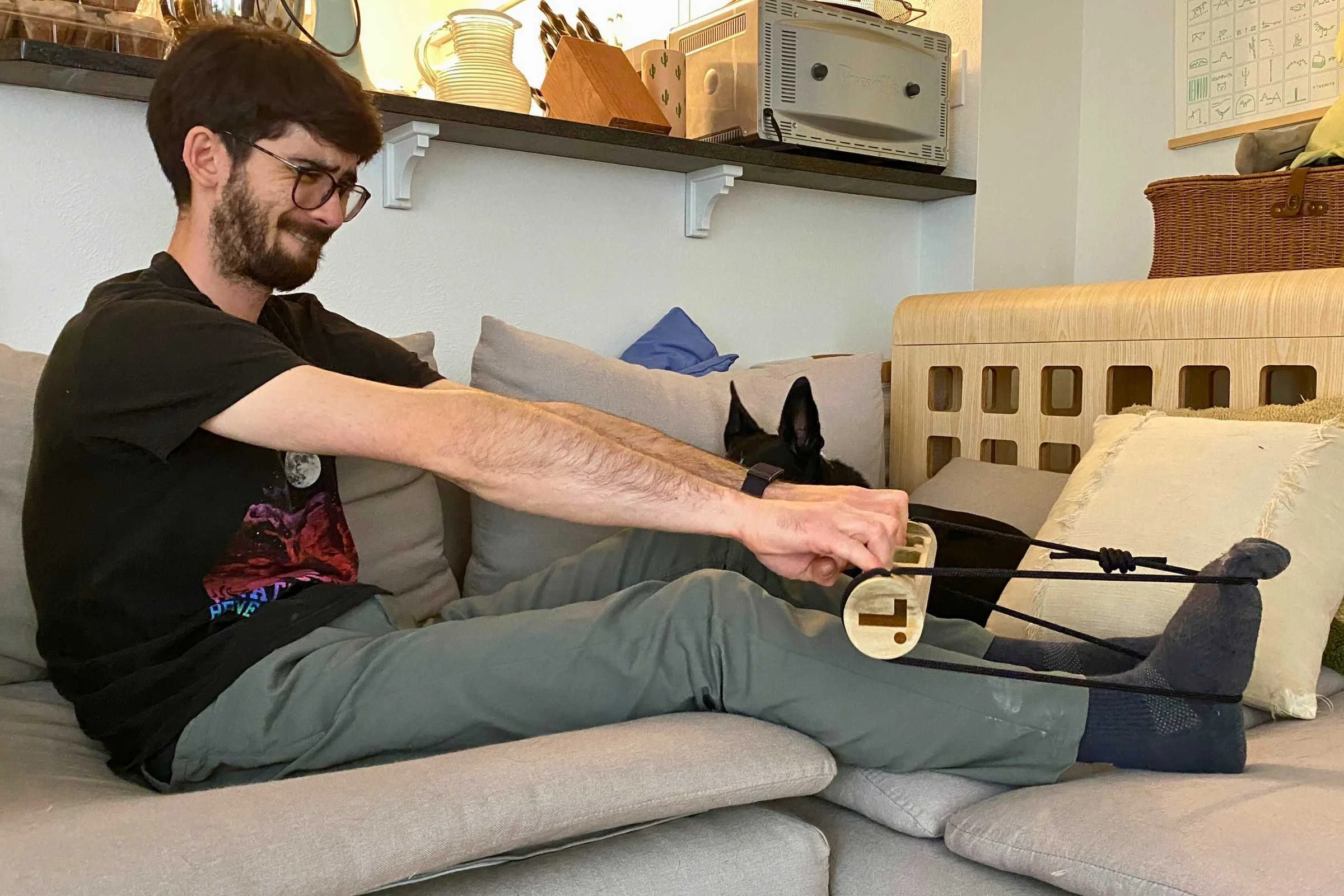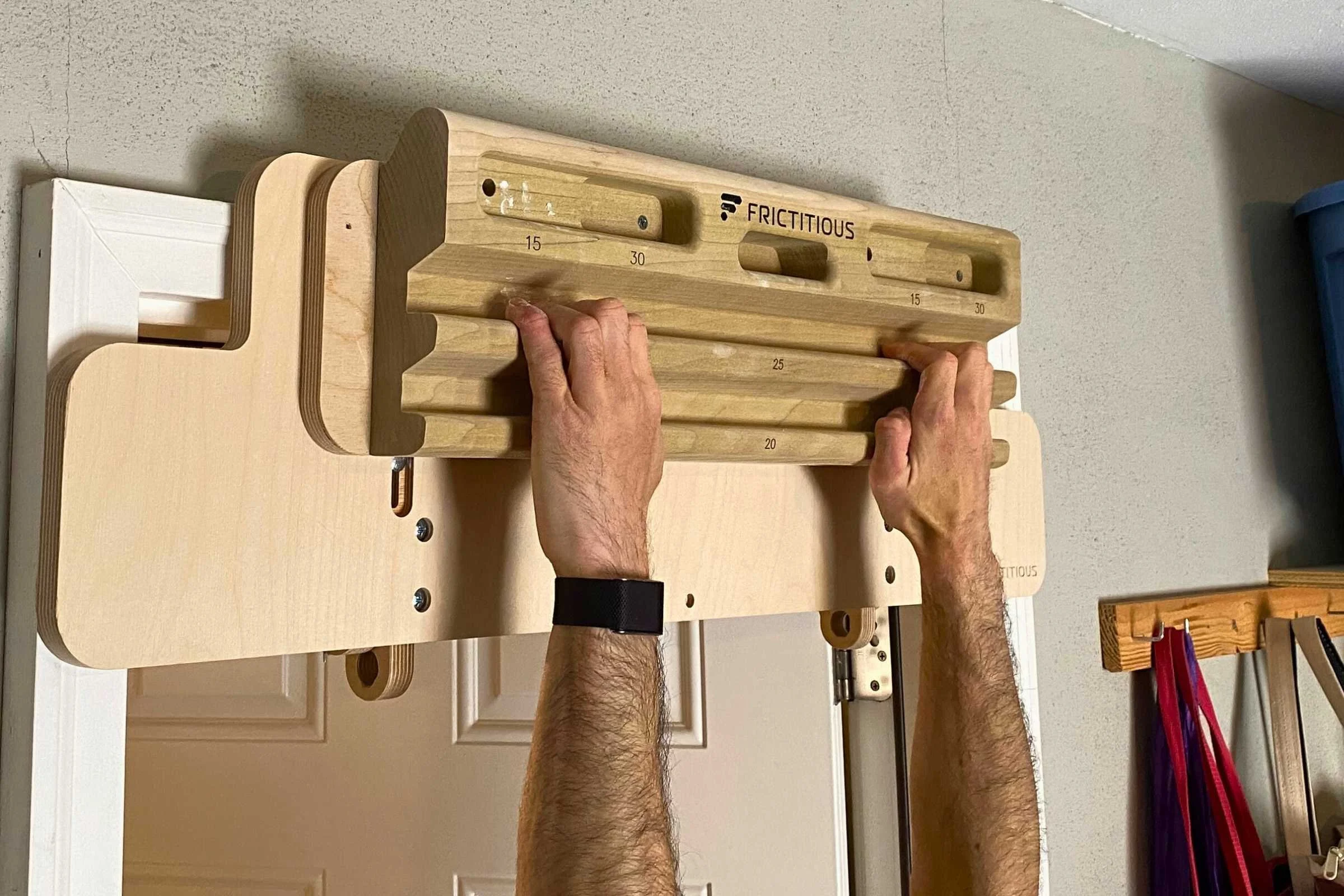Best Hangboards for Climbing of 2025
Hangboards for every climber who wants to train and improve finger strength at home
October 21st, 2025
Home → Gear Reviews → Climbing Gear
One of the quickest ways you can level-up your climbing is by training with a hangboard. Finger strength is crucial in climbing, so being able to hold onto smaller edges can really help accelerate your progress.
But with so many different hangboards out there, it’s hard to know what edge sizes are right for you, whether you should get a plastic board or a wooden board, and how much money to spend. And that’s all if you can even figure out how in the world you’re supposed to mount a hangboard in your home.
To answer all your hangboarding questions, we got 12 of the most popular options out there and pulled on them ourselves. We tested hold comfort, counted all the edges and holds, and yes, we even mounted every single board to judge how easy or difficult the process was.
After all our comprehensive tests, these six hangboards stood out.
We create reader-supported, objective gear reviews independently selected by our editors. This story may contain affiliate links, which help fund our website. When you click on the links to purchase gear, we may get a commission — without costing you an extra cent. Thank you for supporting our work and mission of outdoor coverage for every body! Learn more.
Comparison table
| HANGBOARD | TREELINE AWARD | MSRP | MATERIAL | MOUNT STYLE | WEIGHT | EDGE VARIETY |
|---|---|---|---|---|---|---|
| Frictitious Megalith | Best overall Read why |
$175 | Wood | Screws into mounting plate or studs | 4 pounds 2.3 oz | Great |
| Frictitious Hangboard 3.0 | Best budget Read why |
$120 | Wood | Screws into mounting plate or studs | 4 pounds 15.8 oz | Good |
| Trango Rock Prodigy | Best plastic Read why |
$160 | Polyurethane | Screws into mounting plate or studs | 9 lbs 10.9 oz | Excellent |
| Trango Rock Prodigy Forge | Best for advanced climbers Read why |
$150 | Plastic | Screws into mounting plate or studs | 7 lbs 11.5 oz | Great |
| Tension Flash Board | Best portable Read why |
$95 | Wood | Dual-cord tension | 1 lb 4.4 oz | Good |
The winners
Best overall hangboard: Frictitious Megalith
MSRP: $175
Material: Wood
Edge sizes: Jug, 40mm, 30mm, 20mm, 15mm, 12mm, 10mm, 8mm, 40mm two-finger pockets, mono pockets, 25mm center hold
Edge variety: Great
Mount style: Screws into mounting plate or studs
Weight: 4 pounds 2.3 oz
What we liked: Fantastic hold variety and comfort, easy mounting process, asymmetrical design.
What we didn’t like: A little bit big and heavy, no pinch or sloper holds.
If you want a hangboard that can help you do it all, the Frictitious Megalith is the one for you. The soft wood is comfortable enough for warming up, it has tons of hold variety, and it’s relatively easy to mount. We loved the available edge sizes, and the fact that no matter which edge you’re hanging on, your shoulders are evenly spaced apart.
Frictitious Megalith



-
The Frictitious Megalith had some of the widest hold variety of any board we tested with 11. The Metolius Foundry and the Trango Rock Prodigy Natural also have 11, and the only board that had more holds was the Trango Rock Prodigy. We loved the holds on the Megalith, though they are more oriented towards crimps and jugs. If you want to train pinches or slopers, you’ll need to look elsewhere.
However, if you’re looking to work on finger strength, the Megalith has the holds for you—no matter where you are in your climbing journey. A huge, comfortable jug on the top of the board is great for dead hangs and pull-ups, and while the biggest edge on other hangboards tend to be around 25 to 30 millimeters, the Megalith has a super deep 40 millimeter edge.
But just because the Megalith has large edges for warming up and beginners, if you think this board is only for newbies, you’d be dead wrong. Along with standard depths of 20 and 15 millimeters, this Frictitious board also has edges of 12, 10 and 8 millimeters. Plus, it also has holds to train one and two-fingered pockets, as well as a 25-millimeter edge specifically to train one-arm hangs.
All these edges would be useless if they were uncomfortable, but thankfully, the Megalith was one of the most comfortable hangboards we tested. Hanging from each edge felt comfortable, and none of the angles felt like they were digging into our fingers. Plus, the wood was some of the smoothest we tested, which added even more to the board’s comfort.
One aspect of hold comfort that is sometimes overlooked is the spacing between the edges. Luckily, the Megalith is designed so that your shoulders are evenly spaced apart no matter the hold you’re hanging on.
-
Because the Megalith has so many holds, it is bigger than most of the other boards we tested. It’s heavier than a lot of other wooden boards too, weighing 4 pounds 2.3 ounces, so hanging it up on a doorframe can sometimes feel a bit tiresome, but it wasn’t as bad as some of the plastic boards we tried.
The mounting system itself is quite simple. If you buy it with Frictitious’ doorway mount, the brand will even mount the board to the mount so you won’t have to drill anything (you’ll still need to assemble the mount, but it’s straightforward and you only need a screwdriver). If you mount it yourself, whether that’s on the brand’s mount or a wooden plate you get from the hardware store, there are only six screws that you have to drill.
-
With a wide variety of holds for beginners and experts alike, equal spacing, and edges that feel incredibly smooth and comfortable, the Megalith was our favorite hangboard by far. It’s super easy to set up, especially when paired with the brand’s doorway mount, and can help all your fingers get strong so you can climb harder.
Best budget hangboard and best hangboard for beginners: Frictitious Hangboard 3.0
MSRP: $120
Material: Wood
Edge sizes: Jug, 30mm edge, 15mm edge, 25mm rail, 20mm rail, 50mm center hold
Edge variety: Good
Mount style: Screws into mounting plate or studs
Weight: 4 pounds 15.8 oz
What we liked: Great comfort and deeper holds better for beginners, asymmetric design, good price.
What we didn’t like: A little bit big and heavy, no pinch or sloper holds.
Beginners don’t need as many holds on their hangboard and probably want deeper edges. And since climbing might be pretty new to them, they probably don’t want to drop a ton of money on a training tool, either. If that sounds like you, the Frictitious Hangboard 3.0 should be at the top of your list. It’s simple, but incredibly comfortable and priced right.
Frictitious Hangboard 3.0



-
The Frictitious Hangboard 3.0 doesn’t have as many holds as the Megalith, but it’s got the perfect amount for those just getting into hangboarding. It features a massive jug on the top for pull-ups, deep 30 millimeter holds, rails of 25 and 20 millimeters, and even a smaller edge of 15 millimeters that you can use as your fingers get stronger. It also has a deep, 50-millimeter hold in the center to work on one-arm strength.
Similar to the Megalith, the holds on the Hangboard 3.0 were astonishingly comfortable. Our fingers never felt awkward in any of the edge positions, and the wood felt incredibly smooth.
When we trained on this board, we really loved the deep edges and comfortable angles, as they’re the perfect way to start your hangboarding journey. Fingerboarding is notorious for causing injuries with beginner climbers, so the friendly holds of the Hangboard 3.0 are a great place to start.
-
Just like the Megalith, the Frictitious Hangboard 3.0 is a breeze to set up, especially if you order it along with the brand’s doorway mount. It requires five screws to secure onto the backplate. It’s a bit smaller but heavier than the Megalith, so lifting it onto and off the doorway for each workout feels similar.
-
Frictitious makes some of the most comfortable hangboards we tried, and the Hangboard 3.0 is the perfect option for beginners. It’s more than $50 cheaper than the Megalith, but those new to finger training will have all they need. With rails and edges ranging from 50 to 15 millimeters, the Frictitious Hangboard 3.0 is the best hangboard we tested for beginners.
Best plastic hangboard: Trango Rock Prodigy
MSRP: $160
Material: Polyurethane
Edge sizes: Jugs, slopers, big pinch, small pinch, 2 variable-depth rails, deep 3-finger pockets, small edge, medium 2-finger pockets, medium 3-finger pockets, small 2-finger pockets, staggered 2-finger pockets.
Edge variety: Excellent
Mount style: Screws into mounting plate or studs
Weight: 9 lbs 10.9 oz
What we liked: Biggest variety of holds, including pinches and slopers.
What we didn’t like: Weight and tedious mounting process.
If you like the extra grip of plastic holds, there’s no question you should get the Trango Rock Prodigy. It’s harder to set up than most other hangboards we tested, but it has the most amount of hold variety to help you not only train crimps, but also pinches, slopers, and pockets.
Trango Rock Prodigy



-
What makes the Trango Rock Prodigy really stand out is its hold variety. With a whopping 14 different grips, it’s easy to train crimps, slopers, pockets, and pinches. It features jugs on the top for easy warmups, but the Rock Prodigy also has a sloped angle that makes training for slopers easier than any other hangboard we tried.
The sloper trainers stand out, but the Rock Prodigy doesn’t slouch on crimpy edges either. It has two rails that change in depth, with one end that’s deeper than the other so you can easily train on smaller or larger edges. Not to mention, it also has a great variety of pocket holds for both two and three-finger hangs.
While the variable-depth rails are a fun feature, I didn’t love how some of my fingers were hanging on a deeper edge than others. I personally like the feeling of a consistent edge, but some might find these tapering rails to be more ergonomic.
Another design aspect I didn’t love about the Rock Prodigy is that the edges are symmetrical. That means that the deepest ends of both rails are on the inside, meaning your shoulders will be closer together when hanging on that edge than if you were hanging on the smaller side. We’d much prefer if the holds and depths were on opposite ends, that way, no matter what edge you’re training on, your shoulders will be more or less the same width apart.
All the edges and angles of the Rock Prodigy felt comfortable to hang on and work out with, and the plastic material had a bit more bite than its wooden counterparts. This made some of the workouts, especially on small edges, feel a tad easier. But we did notice more skin sensitivity after using the Rock Prodigy.
A hangboard that wears on your skin isn’t necessarily a bad thing, though. Climbing, whether it’s on plastic holds in the gym or real rock outside, will tear up your skin a lot more, so plastic hangboards can actually help prepare your skin for those workouts better.
-
While we loved using the Rock Prodigy once it was on the wall, getting it up there is a whole other conversation. It was easily one of the most annoying hangboards to mount, but even so, we think it’s worth it (since you only have to mount it once).
To start off, it was the only hangboard we tested that didn’t come with mounting screws. So before you do anything, you’ll have to measure the depth of your mounting setup, along with the depth of the holes in the hangboard, and go buy some wood screws.
After that, we definitely recommend mounting the Rock Prodigy on a mounting board because the hangboard consists of two separate pieces. Leveling and lining up those pieces is a lot easier when you can position them on a piece of wood on the floor.
Since it uses two separate boards, you’ll want to check and double-check your measurements to ensure they’re level with each other, and you’ll also need to make sure they’re properly spaced out so you feel comfortable while hanging—an extra step only required with the Rock Prodigy and the Rock Prodigy Forge. If you mount the two pieces too close, you’ll feel cramped while hanging, and if they’re too far apart, your shoulders might fail before your fingers do.
-
While it’s a pain to mount, once the Trango Rock Prodigy is on your wall it’s a fantastic training tool. The plastic material gives you more grip and it features holds like slopers and pinches that aren’t found on many other boards we tested. It isn’t the most comfortable hangboard we tested, and we wish the design was asymmetrical, but those complaints aren’t big enough to discredit the amazing training versatility you get.
If you want a plastic board, the Rock Prodigy is a clear choice—unless you’re an advanced climber who’s looking for an even harder workout. If that’s you, read on to see why we’d recommend the Trango Rock Prodigy Forge.
Best hangboard for advanced climbers: Trango Rock Prodigy Forge
MSRP: $150
Material: Plastic
Edge sizes: Wide pinch, medium pinch, small pinch, 25mm 2-finger pocket, 15mm 2-finger pocket, variable depth edge rail, 7.5mm closed crimp, staggered 3-finger pocket.
Edge variety: Great
Mount style: Screws into mounting plate or studs
Weight: 7 lbs 11.5 oz
What we liked: Hardest edges and holds of any hangboard we tested.
What we didn’t like: Annoying mounting process.
If you want a harder training experience on smaller edges and steeper angles, look no further than the Trango Rock Prodigy Forge. It has similar setup hurdles as the original Rock Prodigy, but with crimps as small as 7 millimeters, even the strongest fingers can find room for improvement.
Trango Rock Prodigy Forge



-
Clocking in with 10 different holds and edges, the Trango Rock Prodigy Forge has more than enough variety to keep any climber occupied. Similar to the original Rock Prodigy, it has better pinch and sloper options than most other boards we tested. However, the angles and grips on the Forge are more difficult. The slopers and pinches are at steeper angles, which makes them better suited for those with more advanced training abilities and goals.
But the difficulty doesn’t stop there. The variable rails on the Prodigy range from 20 millimeters down to 7 millimeters, with a separate 7.5-millimeter edge that has a thumb catch to help you practice closed crimps.
The plastic itself has a nice grippy texture that helps you hold onto the tiny edges, but it does wear down your skin. During our testing, even though the holds were difficult, we never experienced any pain or discomfort from the design of the holds themselves. We wish the design was asymmetric like some of the other boards we tested—which would prevent your shoulders from feeling cramped—but besides that, we didn’t have any complaints in the comfort department.
-
Just like the original Rock Prodigy, the Rock Prodigy Forge is a pain to mount. It’s lighter and has a smaller profile, so it is easier to fit on a mounting plate, but you’ll still have to carefully level and space each of the two pieces.
When we were setting up the Rock Prodigy Force, we placed it beneath the original in our mounting rankings because not only do you have to deal with the leveling, but also because our drill was partially blocked when we were trying to drill the outer screws. We were still able to get the screws in, but we had to hold our drill at an odd angle. We definitely wish these screw holes were in a different position to give the drill more clearance.
-
If you want to upgrade your training program, the Trango Rock Prodigy Force was the hardest hangboard we tested by far. You can train slopers, pinches, pockets, and tiny crimps—just make sure to set aside loads of time for mounting.
Best portable hangboard: Tension Flash Board
MSRP: $95
Material: Wood
Edge sizes: 20mm, 15mm, 10mm, 8mm, small crimps
Edge variety: Good
Mount style: Dual-cord tension
Portability: Good
What we liked: Portable design, best variety of holds of compact boards, super stable.
What we didn’t like: Not the smoothest wood, not as portable as some others.
The Tension Flash Board is an extremely versatile board that was our favorite for bringing to the crag. It isn’t the smallest, but it’s portable enough and, most importantly, has the widest variety of holds out of all the portable boards we tested.
Tension Flash Board



-
The thing that made the Tension Flash triumph over all the other portable hangboards we tested is simple: it has the widest variety of holds. With a total of eight edge positions, the Flash had three more than its closest compact competitor. That means it was the most versatile and easiest to use for any workout, whether you’re warming up below your project or training on your couch.
All the portable hangboards we tested had a focus on crimps, and the Flash was no different. It has edges ranging from 20 millimeters down to ones smaller than 8 millimeters, with options to pull using two hands or just one. The edges themselves were decently smooth (though not as smooth as the Nature Climbing wooden edges), and were all comfortable to pull on.
A big issue many portable hangboards have is tipping. If the cord isn’t balanced correctly, the board can tip forward or backward, making it harder to hang. The Tension Flash board solves this problem in a simple yet genius way, by wrapping the cord through the board. Since the cord runs through and around the cylinder shape of the board, when you tension it, the entire contraption becomes extremely stable. This gave the Tension Flash the most stable hanging experience out of any portable hangboard we tested by far.
What’s also great about this setup is that you can adjust the cord, which also adjusts the angle of the board. This is helpful since there are edges on both the front and back (which don’t always feel level right away), but also because it gives you the ability to control how much the edge is tilted, so you can make hanging easier or harder.
-
The Tension Flash isn’t the most portable hangboard we tested, but it more than makes up for it with its wide variety of holds. And even though it is bigger than most other portable boards we tested, it’s still super easy to bring to the crag. It easily fits in a crash pad for your bouldering projects, and it should fit in most backpacks, too.
It’s a little over 17 inches long, but it needs to be so you can comfortably pull with two hands. If you want an even smaller board, check out some one-handed options like the Nature Climbing Stone Hanger or the Metolius Nano Rings.
-
It isn’t the smallest hangboard, but if you want a compact way to help you warm up or train hard, there’s no other hangboard that can compete with the Tension Flash. It has the most edges out of any portable hangboard we tested, and its clever way to prevent tipping was our favorite by far.
Best hangboard for conditioning skin: Nature Climbing Stone Hanger
MSRP: $108
Material: Wood and granite or sandstone
Edge sizes: 20mm, 15mm, 10mm, 6mm
Edge variety: Okay
Mount style: Attach to weights or hang with carabiner and extra cord.
Portability: Excellent
What we liked: Tiny yet efficient design, real rock used on the 20mm edge.
What we didn’t like: Not as many holds as some other portable boards, small cord.
This portable hangboard has a sleek design that makes warming up at the crag a breeze. It’s a great one-handed option for attaching to weights or a sling for at-home workouts, but what makes it stand out is its materials. Alongside a super smooth wooden construction, this board from Nature Climbing has an edge that features real Norwegian granite.
Nature Climbing Stone Hanger



-
This tiny hangboard fits a surprising amount of edges in such a compact package, featuring four depths from 6 millimeters to 20 millimeters. It doesn’t have as much variety as the full-sized boards or even the Tension Flash, but you can definitely get by with the holds available on this little guy.
What really made the Nature Climbing Stone Hanger stand out, though, is in its name. It uses real stone on the 20 millimeter edge to provide a completely unique experience while hangboarding.
During testing, we weren’t sure if we would like the feel of the rock edge, or if it would feel like a gimmick. However, after we used it a few times, we fell in love. There’s really nothing that can mimic the feel of real rock, which is why it’s so cool that Nature Climbing is able to use it in its products. The texture felt great on our skin, and while it’s much rougher than all the other wooden and plastic edges we tested, it’s a fantastic way to warm up and prepare for your outdoor projects.
Your skin (and brain) can sometimes feel a bit shocked when you first pull on to small holds on real rock, but the Nature Climbing Stone Hanger helps mitigate that. It’s like having the perfect warmup jug always at your disposal to get your skin and mind ready to try hard on rough textures. But even if you’re not using it right before an outdoor session, it’s a great way to prepare your skin for those severe conditions. For example, when it’s too hot and humid to climb during the summer, you can use this hangboard to keep your skin thick and in tip-top shape.
It might not be a big deal to many, but outdoor climbers who want to keep their skin ready for real rock—or people who just love the feeling of pulling on stone—will love the Stone Hanger.
-
The Stone Hanger is tiny, and one of the smallest hangboards we tested. Since it’s only meant for one-handed pulling, it can easily fit in any bag. It’s a bit heavier than other one-handed options we tested due to the stone, but the difference is negligible.
One thing that is worth noting, though, is that the cord on the Stone Hanger is quite small. For basically any workout, you’ll need a carabiner and a sling to use it. This adds a bit more weight and setup hassle, but not much.
-
It’s pricey, but the novel experience of pulling on real rock while sitting on your couch is hard to beat. The Nature Climbing Stone Hanger is an awesome tool for keeping your skin prepped for hard outdoor projects, and is versatile and portable enough that you’ll be bringing it to every session at the gym and your outdoor crag.
Other hangboards we tested
Tension Grindstone
MSRP: $171
Material: Wood
Edge Sizes: Jug, 50mm one arm jug, 30mm, 25mm, 20mm, 15mm, 10mm, 8mm.
Edge Variety: Good
Mount Style: Screws into mounting plate or studs
The Tension Grindstone has an asymmetrical design to keep your shoulders comfortable while hanging, but it didn’t have as many holds or feel quite as comfortable as the Frictitious Megalith. It’s a great board, but for a similar price, we think the Megalith is the better buy.
Tension Grindstone
The Tension Grindstone has an asymmetrical design, but it wasn’t as comfortable to hang on as the Frictitious.
MSRP: $100
Material: Polyester resin
Edge Sizes: Pinches, jugs, 32mm, 30mm, and 22mm pockets, 21mm, 15mm pockets, sloper, 16mm, 2mm3, 30mm edges
Edge Variety: Great
Mount Style: Screws into mounting plate or studs
Some of the holds and edges on the Metolius Foundry felt awkward to hold onto, but this board had some of our favorite pinch grips. It doesn’t cost much, but the cramped hanging positions knocked it out of contention.
Metolius Foundry
The pinch holds on this board were great, but we felt cramped while hanging on the rails.
MSRP: $122
Material: Wood
Edge Sizes: Jug, 25mm, 14mm, if you buy sliders you can also get access to edges of 21mm, 16mm, 10mm, 6mm
Edge Variety: Good
Mount Style: Screws into mounting plate or studs
The Nature Climbing Oak Board has a comfortable jug, a 14mm edge, and a 25mm edge. The 25mm rail is angled slightly downward, which makes it harder to hold on to than other 25mm grips we tested. The wood itself was the smoothest and most comfortable we tested, but we think the variety of the Frictitious Hangboard 3.0 was better. You can also add sliders to the Oak Board for $27 that make the edges smaller, but for $25 more than that, you can get even more edges and useful holds on the Megalith.
Nature Climbing Oak Board
The Nature Climbing Oak Board was one of the most comfortable we trained with, but it doesn’t have as much hold variety.
MSRP: $100
Material: Wood
Edge Sizes: Jug, big pinch, medium pinch, 38mm, 33mm, 24mm, 20mm, 10mm, 10mm with thumb catch, 27mm two-finger pockets, 27mm three-finger pockets.
Edge Variety: Great
Mount Style: Screw rail cleats into mounting plate or studs, screw holds onto smaller cleats, then attach holds to rails.
The Trango Rock Prodigy Natural was one of our favorite boards that didn’t make the top cut. The hold variety is solid and hanging felt comfortable, but the set up was a pain. This set comes with small rails that you attach to your mounting plate, and a couple of other wooden pieces that you attach the holds to. With this design, you can move the two pieces further or closer on the set rails, which makes finding the right hanging position super easy. However, compared to the other wooden options we tested, this mounting system was too complicated.
Trango Rock Prodigy Natural
We liked the adjustability of these Trango wood boards, but the mounting process was more difficult than others.
MSRP: $30
Material: Wood
Edge Sizes: Jug, 25mm, 20mm, 15mm, 10mm
Edge Variety: Okay
Mount Style: Single cord to hang over branch, foot, or pull-up bar
Portability: Excellent
If you want a budget portable board just to warm up your fingers, the Metolius Nano Rings are a fantastic option. Featuring a jug and edges of 25, 20, 15, and 10 millimeters, there are plenty of holds to work out on. Our biggest problem with the Nano Rings was their tipping and balance. The Tension Flash felt much more stable, but if you’re on a budget, the Nano Rings can still suffice.
Metolius Nano Rings
The smallest hangboard we tested, the Nano Rings are comfortable but don’t have as much variety as the Tension Flash Board.
MSRP: $50
Material: Wood
Edge Sizes: 40mm, 26mm, 19mm, and 15mm
Edge Variety: Okay
Mount Style: Single cord to hang over branch, foot, or pull-up bar
Portability: Good
Similar to the Nano Rings, our biggest issue with the Metolius Light Rail 2.0 was its stability. However, it is less than half the price of the Tension Flash, so it could definitely be worth it for cost-conscious climbers. It has the fewest holds of any board we tested, with just a jug, a 20-millimeter rail and a 15-millimeter rail, but if you want a beginner-friendly portable board for cheap, this is a solid pick.
Metolius Light Rail 2.0
The Metolius Light Rail 2.0 portable board has a great price, but doesn’t have as many holds as the Tension Flash Board.
What to look for in a climbing hangboard
The best hangboard is one that you like to use. Here, we’re breaking down everything you need to know to ensure you buy the right hangboard the first time. From materials and portability to hold size and variety, here are all the things you should look for in your next hangboard.
Material
There are three main materials you’ll find in a hangboard. The most common is wood, but plastic options are also popular. There are two types of plastic hangboards: polyester resin and polyurethane. Resin boards are typically heavier and can chip more easily, but besides that there isn’t much of a difference between the two, and both tend to be more durable than wooden boards.
When picking between a wooden or plastic board, the biggest factor you’ll want to consider is the grip the material gives you and what it will do to your skin. Plastic boards have manufactured texture that makes them easier to hold onto in general. That means you can probably hang onto smaller edges, but it’ll cost you some skin. Wooden boards, on the other hand, are a lot softer and smoother than plastic ones, which means they’re the better option if you want to hang as a warm-up and preserve your skin. Many folks also think wooden boards feel more comfortable, which we also experienced in our testing.
On top of the typical materials, one brand we tested, Nature Climbing, is even using real stone in its hangboards. We tested the Stone Hanger, which is a portable hangboard that has a piece of stone on one of its edges. The brand also makes a larger board with stone edges, the Stoak Board II. These stone edges have a lot more grip than both wooden and plastic boards in our experience, but similar to plastic edges, will wear your skin down more than wooden options.
Edge depth and shape variety
The perfect hangboard for you should have a variety of edges and shapes to ensure you can train whatever you want. Larger edges are critical for warming up, while smaller edges are great for tracking your gains. Most boards focus on edges for crimps, but many boards also have cutouts or holds to train for pockets and slopers.
Mounting system
Mounting a hangboard can be the most intimidating part of your buying decision, but there are plenty of options that are renter and doorway friendly. Most commonly, people mount hangboards over a doorway, since the open space gives your body room to swing while you’re training. We detail different methods of how to actually install a hangboard below, but in short, you can drill it above your doorway, buy a separate mounting system like this one from Frictitious Climbing, or jury-rig your own setup with a doorframe pull-up bar.
If you want to avoid mounting completely, a portable hangboard might be the better option for you.
Grip comfort and skin-friendliness
You want to make sure your hangboard is comfortable to train on, and the design of the grips is crucial to that. Edges should be rounded so they don’t dig into your fingers, and they should be wide enough to actually fit all the fingers you’re trying to train without feeling cramped.
Hangboard training can also deteriorate your skin, depending on the type of board you have. Wooden boards are generally easier on your skin, which makes them great for warming up, but the lack of friction might make them feel more slippery. Plastic boards, on the other hand, have better grip, but will take off more skin.
If you’re interested in wearing gloves, check out our guide to the Best Climbing Gloves.
Size and portability
You should also think about the size of the hangboard you want. Some are small enough to fit in your jacket pocket and have just a few edges so you can train the basics, while others are the width of your doorway and have a wide variety of holds. Figure out how seriously you want to take finger training, what sort of holds you want to train, and find a board that fits those goals.
If you want a board that you can take to the crag to warm up your fingers, you’ll want to look at portable hangboards. Some are one handed, some are two handed, but all should be lightweight enough to comfortably stash in your pack and carry to your project. Most portable hangboards only have a few edges, since they’re mostly tailored for warming up, but some have clever designs that fit a surprising amount of holds.
Training progression features
If you’re still early on in your climbing career and you’re buying your first hangboard, you’ll probably want to look for one with plenty of edge sizes and different features so your workouts aren’t too difficult. Training intensely on edges that are too small for you is a recipe for injuries, so look for hangboards with jugs for warming up (normally on the top of the board) and edges that are at least 20 millimeters deep. This is a great starting point for climbers trying to strengthen their fingers.
As your fingers get stronger, you can move to smaller edges or start adding weight to make the workouts harder. And if you want to train slopers, some boards have steeper angles so you can progress with more difficult holds.
Benefits of using a hangboard
You don’t have to hangboard to get strong fingers and progress at climbing, but it sure can help. And before you say anything, yes, we know Janja Garnbret said she’s never used a hangboard. If you think you have the same genetics as arguably the most dominant climber of all time, don’t train your fingers and just climb. But, if you find that finger strength is a limiting factor for you, hangboards are certainly a great way to improve.
There are countless ways to train on a hangboard, and they can help increase your strength in different grip types, including open-hand crimps, half crimps, and full crimps, as well as pockets and slopers. You can also hang with just a few of your fingers to train different hold types. On top of increasing your strength, hangboards can help with finger strength endurance, too.
How to install a hangboard
As we said before, the most common way to install a hangboard is over a doorway. To do this, it’s important to have the hangboard itself, as well as a mounting board. Some brands sell mounting boards, but they’re really just a sturdy piece of wood that you could buy from a local hardware store. Just make sure to get one that’s at least ¾-inches thick to ensure it’s strong enough to hold your weight.
You’ll want to find the studs above your doorway, drill the mounting board to the studs, and then you can drill the hangboard itself into the mounting plate.
If you don’t want to drill into your walls, don’t worry, because you still have options. My favorite is from Frictitious Climbing, as they have a simple, plug-and-play doorway mount that can be set up in a minute or two, and can be paired with the brand’s own hangboards, or any other hangboard if you use the brand’s mounting plates.
Leveling and mounting one-piece boards is easier than mounting two-piece boards.
Climbers are notorious for their dirtbang tendencies, so if you want to really DIY it and save a few bucks, you can build a similar setup (though not nearly as stable and a tad sketchy) at home with a doorframe pull-up bar. This video gives you an idea of what you can do with a traditional hangboard, but if you have a portable hangboard like the Tension Flash Board, you can simply wrap the board’s cord over one or both of the bar’s handles and hang from there.
If you’re interested in building a climbing wall, check out our guide on How to Build a Home Climbing Wall.
Mounting over a doorway is the most common way to install a hangboard at home.
How to train with a hangboard
Training with a hangboard can look completely different from one climber to the next, and how you use the board depends on what you want to get out of it. Most commonly, people hang on edges to increase their finger strength.
A basic example of a training program would consist of hanging on an edge for 10 to 20 seconds, taking 45 to 60 seconds to rest, then hanging again. Doing this five or six times could be a set, and you could repeat this set another five or six times. As this workout gets easier, you could hang on smaller edges, or start adding weight to make it more difficult.
To train endurance, you want to make sure you hang on a comfortable hold, and over time you’ll want to either hang for longer, take less rest, or both. That way, your fingers and forearms don’t have as much time to recover and you can build up stamina so you can spend more time on the wall.
It seems like there’s a new optimized or trendy hangboard workout every year, but at the end of the day, if you can find one that you enjoy and actually increases your finger strength, that’s all you can ask for.
Edges and holds should be comfortable so you don’t experience any pain when training.
Care and maintenance tips
If you use climbing chalk while you train, it’s important to frequently brush the holds of your hangboard. If you don’t, the chalk can clog the pores of the wood or plastic, and the holds will feel much more slippery.
If you have a portable hangboard, make sure to brush any dirt and chalk off it before you store it to ensure it lasts for years, and keep it in a cool, dry space (away from humidity) to prevent the materials from getting damaged.
Keeping the hangboard itself in good shape isn’t too hard, but what about your home and doorframe? Renters will definitely want to be wary of any spots where your hangboard mounting system puts pressure on the doorframe. After repeated use, the forces from training can chip paint and warp wood.
To help prevent this, it’s a good idea to stick something like rubber bumper stickers in between your hangboard and the doorframe. You should also examine your doorframe for any damage, especially after your first few workouts, and adjust any padding if necessary to ensure you get your security deposit back.
How we researched and tested
We trained with every hangboard to find the best.
To find the best hangboards on the market, we spend months researching the most popular and best reviewed options out there. We then ordered all 12 hangboards to test in real life, and conducted multiple standardized tests to find which ones were better than the rest.
We used each hangboard multiple times, comparing hold variety, hold comfort, and general feel. For portable hangboards, we used them on the couch and at the crag to see how stable they felt, and for full-sized hangboards, we mounted each and every one.
We used the Frictitious Hangboard Doorway Mount, a couple of the brand’s Hangboard Swap Plates, and even wooden 2”x6”s to ensure we mounted each hangboard correctly and safely.
Our testing process
We spent months researching the most popular and best-reviewed options, then ordered all 12 hangboards to test in real life. We used each board multiple times and ran standardized tests, comparing hold variety, hold comfort, and overall feel.
What we test
- Hold variety
- Hold comfort
- General feel during sessions
How we tested
- Mounted each full-sized hangboard
- Used portable boards on the couch and at the crag
- Multiple sessions per board
Why you should trust us / About the author
Kai Burkhardt is an avid climber and has been climbing for nearly a decade. He’s gone through obsessive phases of fingerboarding, and has tried all sorts of different regimens throughout the years.
Burkhardt loves tiny crimps and training on tiny holds, so he used his years of crimping experience to judge each hangboard. Between his home hangboard setup and warm ups at the crag, he spent hours pulling on all sorts of manufactured edges just for this guide.


